A Congestion Control Strategy for Power Scale-Free Communication Network
Abstract
:1. Introduction
2. Power Communication Network Model
- The provincial power communication network is set as a unit, and only the communication networks of 110 kV and above are considered, including power plants, substations and dispatching institutions.
- The communication nodes and dispatch centers of the stations (power plants, substations and converter station) are abstracted as nodes without differences.
- The communication lines between communication nodes are abstracted as edges. The communication lines are bidirectional communication, and the differences between the communication lines are ignored, that is none of the edges have weights or direction.
- Multiple communication links in the same direction are merged, and self-loops are eliminated.
3. Congestion Control Strategy for the Power Scale-Free Network
3.1. Allocation of Resources to Communication Nodes
- Bi is the betweenness of power communication node i, and it is denoted by the number of the shortest paths through node i.
- Ci is the delivery capacity of power communication node i, and it is denoted by the maximum number of packets Ci that node i can deliver at each time step.
- Li is the maximum number of packets that power communication node i can cache, and when the cache capacity is full, the incoming packets will be discarded.
- ni is the queue length of node i, and it is denoted the load of power communication node i.
3.2. Classification of Power Communication Services
3.3. Integrated Routing Strategy
- Step 1:
- The topological graph is constructed based on the modeling rules;
- Step 2:
- Wait for the business request. The fixed routing table is obtained based on the open shortest path priority protocol (OSPF). Additionally, the routing update module can quickly inform all nodes of the current state in the network. Each node counts periodically the queue length in turn and updates its global dynamic routing table.
- Step 3:
- Each node has two queues that store two levels of services. When the packet polling scheduler polls the queue, if the queue length of the node ni > Ci, the Ci packets are put in the polling scheduler or else, ni packets are put in the polling scheduler. For an incoming packet, it can be routed to the destination through two outgoing ports depending on different packet levels.
- Step 4:
- Recalculate the queue length of nodes in the network and update the dynamic routing table.
3.3.1. Shortest Path Routing
3.3.2. Global Dynamic Routing
- Initially, the routing table is empty, and the real-time queue length of each power communication node can be denoted as n(1), n(2), n(N);
- According to the queue length and delivery capacity of the nodes in the path, the cost of the multiple paths from the source to the destination are calculated by Equation (4);
- The least cost path is selected to deliver packets, and the routing table is updated according to the real-time load of nodes at each time.
- The initialization module involves the description of the common constant, type and global variable.
- The routing update module is the procedure for realizing the dynamic and adaptive routing protocol. This module can quickly inform all nodes of the current state in the network. Each node counts periodically the queue length in turn and updates its global dynamic routing table.
- The routing decision module is the procedure of the global dynamic routing protocol. It is based on Equation (4) and allows the optimal routing to be found by computing the multi-segment map.
3.4. Critical Packet Generation Rate
4. Simulation Results
4.1. Model-Beijing Power Communication Network
4.2. Simulation Results for Node Resource Allocation
4.3. Simulation Results for Global Dynamic Routing
4.4. Simulation Results for Integrated Routing
5. Conclusions
Acknowledgments
Author Contributions
Conflicts of Interest
References
- Wang, D.; Chen, C.P.; Yan, J.; Guo, L.; Lai, F.G. Pondering a New-generation Security Architecture Model for Power Information Network. Autom. Electr. Power Syst. 2016, 40, 6–11. [Google Scholar]
- Fan, B.; Tang, L. Vulnerability Analysis of Power Communication Network. Proc. CSEE 2014, 34, 1191–1197. [Google Scholar]
- Peng, H.; Tao, H.Z.; Yan, Y.Q.; Wang, J.; Ji, X.C.; Xie, X.D.; Liu, T. Database Management Technology for Smart Grid Dispatching and Control Systems. Autom. Electr. Power Syst. 2015, 39, 19–25. [Google Scholar]
- Zhang, X.P.; Zeng, R.J.; Chen, H. Service Characteristics and Key Technologies of the Smart Grid Communication. Telecommun. Electr. Power Syst. 2012, 33, 80–84. [Google Scholar]
- Amjad, A.M.; Josep, M.G. Special Issue on Advances in Integrated Energy Systems Design, Control and Optimization. Appl. Sci. 2017, 7, 1–3. [Google Scholar]
- Chen, L.J.; Mei, S.W.; Chen, Y. Smart Grid Information Security and Its Influence on Power System Survivability. Control Theory Appl. 2012, 29, 240–244. [Google Scholar]
- Zeng, Y.; Li, W.J.; Chen, Y.Y.; Tang, L.R. A congestion avoidance algorithm based on the service priority for electric power dispatching data network. Power Syst. Prot. Control 2014, 42, 49–55. [Google Scholar]
- Fan, B. An Improved Routing Method for Electric Power Communication Networks. Am. J. Netw. Commun. 2016, 5, 115. [Google Scholar]
- Zhao, T.; Wang, B.; Gao, Q. Congestion warning method based on the Internet of vehicles and community discovery of complex networks. J. China Univ. Posts Telecommun. 2016, 23, 37–45. [Google Scholar]
- Benyoussef, M.; Ezzahraouy, H.; Benyoussef, A. Optimal topology to minimizing congestion in connected communication complex network. Int. J. Mod. Phys. C 2017, 28, 1750073. [Google Scholar] [CrossRef]
- Evropeytsev, G.; Dominguez, E.L.; Hernández, S.E.P.; Cruz, J.R.P. An Efficient Causal Group Communication Protocol for Free Scale Peer-to-Peer Networks. Appl. Sci. 2016, 6, 234. [Google Scholar] [CrossRef]
- Liu, W.Y.; Liu, B. Study on congestion control for complex network based onweighted routing strategy. Syst. Eng. Theory Pract. 2015, 35, 1063–1068. [Google Scholar]
- Liu, G.; Li, Y. Study on the congestion phenomena in complex network based on gravity constraint. Acta Phys. Sin. 2012, 61, 108901. [Google Scholar]
- Ling, X.; Hu, M.B.; Jiang, R.; Qing, S.W. Global dynamic routing for scale-free networks. Phys. Rev. E Stat. Nonlinear Soft Matter Phys. 2010, 81, 016113. [Google Scholar] [CrossRef] [PubMed]
- Xu, P.; Hong, C. A global dynamic routing strategy based on capacity utilization ratio on scale-free networks. J. Natl. Univ. Def. Technol. 2013, 35, 109–113. [Google Scholar]
- Sheng, M.; Shi, Y.; Peng, C.W. A congestion avoidance routing protocol for cognitive scale-free networks. In Proceedings of the 2012 75th IEEE International Conference on Vehicular Technology, Yokohama, Japan, 16 July 2012; pp. 156–161. [Google Scholar]
- Zou, Y.; Li, Z. Optimal Routing Strategy on Scale-free Networks with Heterogeneous Delivering Capacity. Int. J. Future Gener. Commun. Netw. 2015, 8, 1–8. [Google Scholar]
- Fu, Y.; Gao, Q.; Yu, P. Discussion on power communication network platform construction based on multi service VPN. In Proceedings of the 2003 28th International Conference on China Electric Power Control and Operation Thesis Florilegium, Beijing, China, 21–23 October 2003; pp. 852–856. [Google Scholar]
- Danila, B.; Sun, Y.; Bassler, K.E. Collectively optimal routing for congested traffic limited by link capacity. Phys. Rev. E Stat. Nonlinear Soft Matter Phys. 2009, 80, 066116. [Google Scholar] [CrossRef] [PubMed]
- Echenique, P.; Gómez-Gardeñes, J.; Moreno, Y. Improved routing strategies for Internet traffic delivery. Phys. Rev. E Stat. Nonlinear Soft Matter Phys. 2004, 70, 056105. [Google Scholar] [CrossRef] [PubMed]
- Arenas, A.; Díazguilera, A.; Guimerà, R. Communication in networks with hierarchical branching. Phys. Rev. Lett. 2001, 86, 3196–3199. [Google Scholar] [CrossRef] [PubMed]
- Xing, N.Z. Empirical analysis on complex network characteristic of power optical fiber communication network. Opt. Commun. Technol. 2014, 38, 1–4. [Google Scholar]
- Wang, W.X.; Wang, B.H.; Yin, C.Y.; Xie, Y.B.; Zhou, T. Traffic dynamics based on local routing protocol on a scale-free network. Phys. Rev. E 2006, 89, 026111. [Google Scholar] [CrossRef] [PubMed]
- Jiang, Z.Y.; Liang, M.G. Improved efficient routing strategy on scale-free networks. Int. J. Mod. Phys. C 2012, 23, 50016–50022. [Google Scholar] [CrossRef]
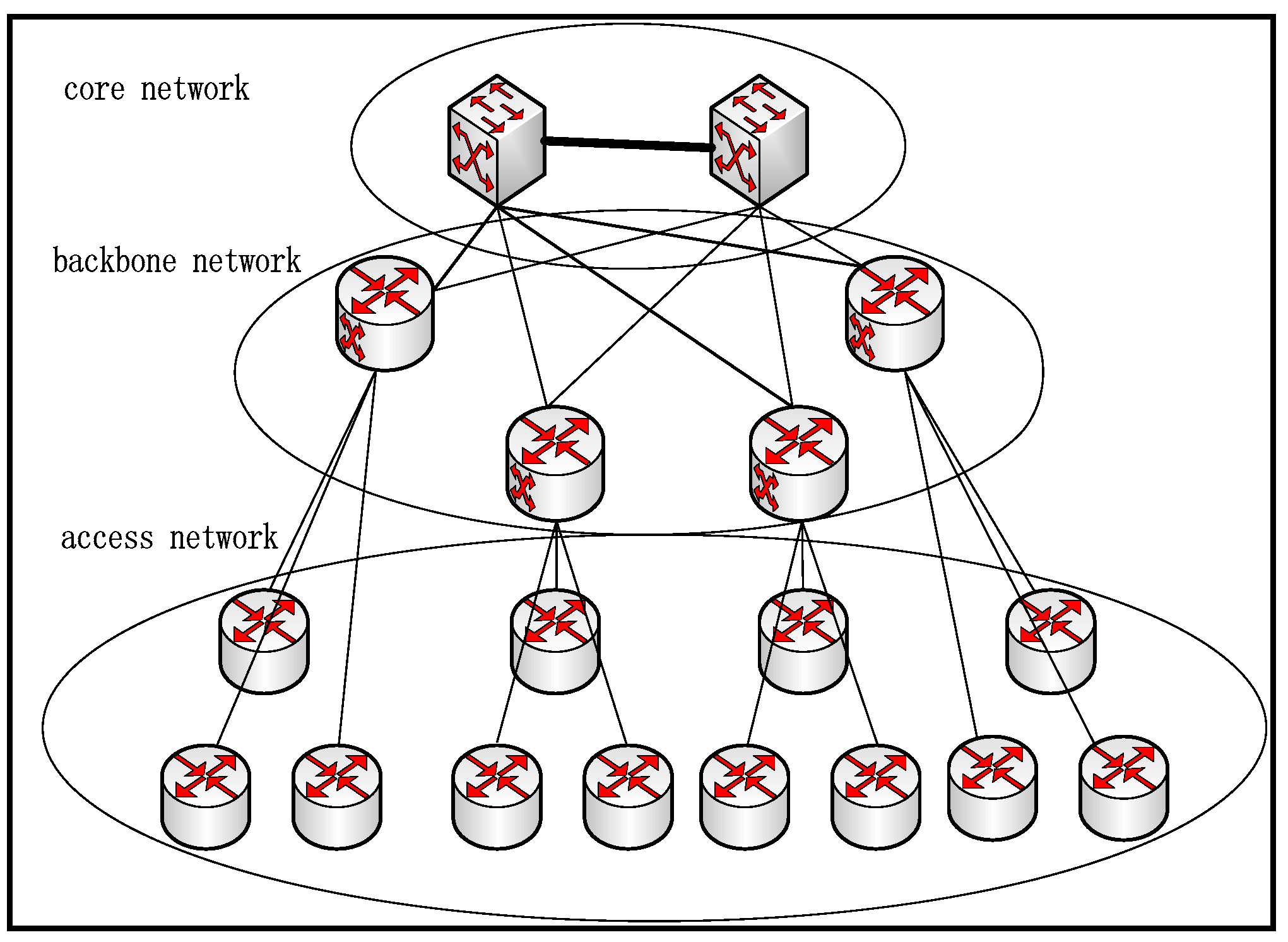
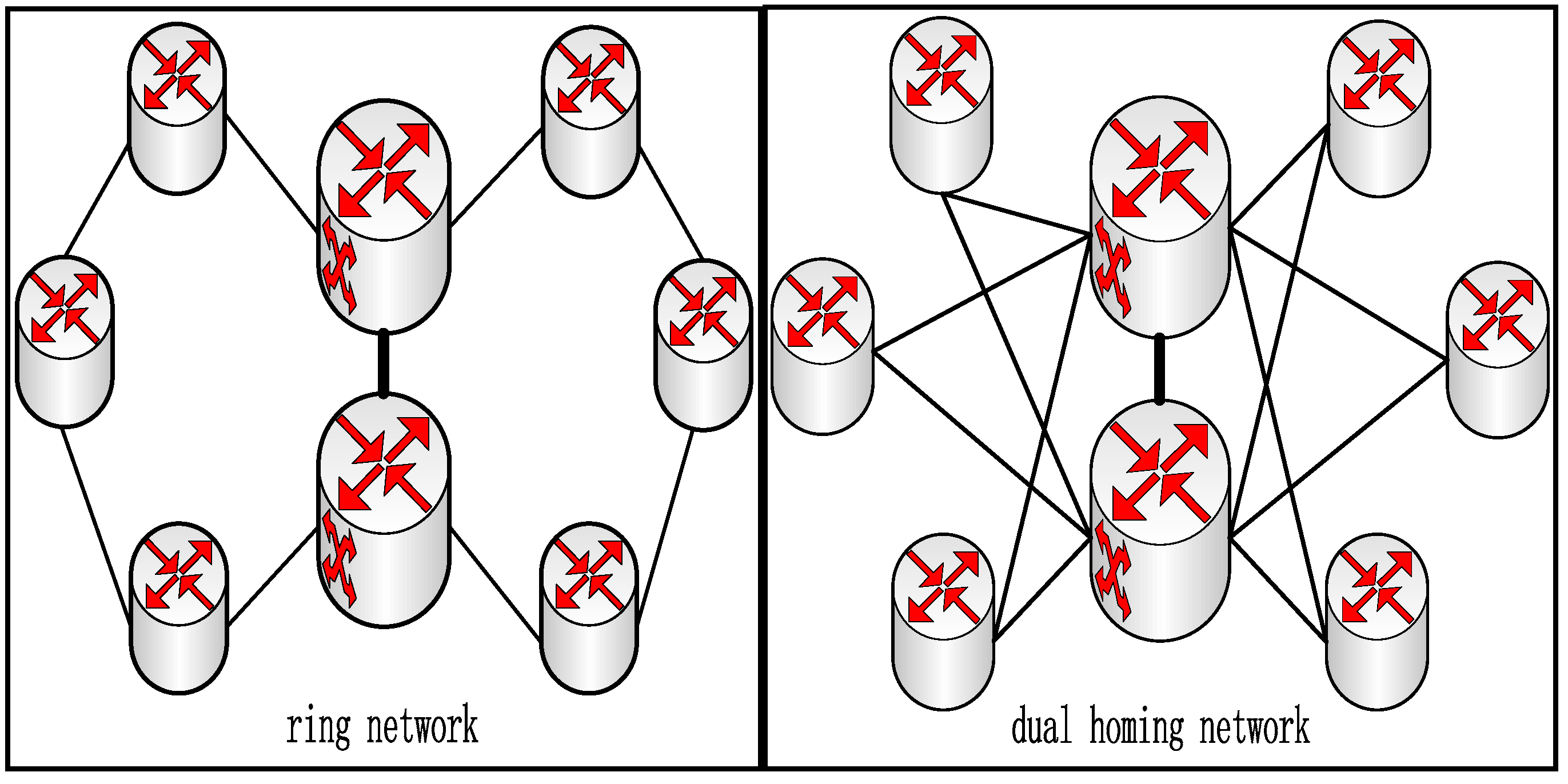
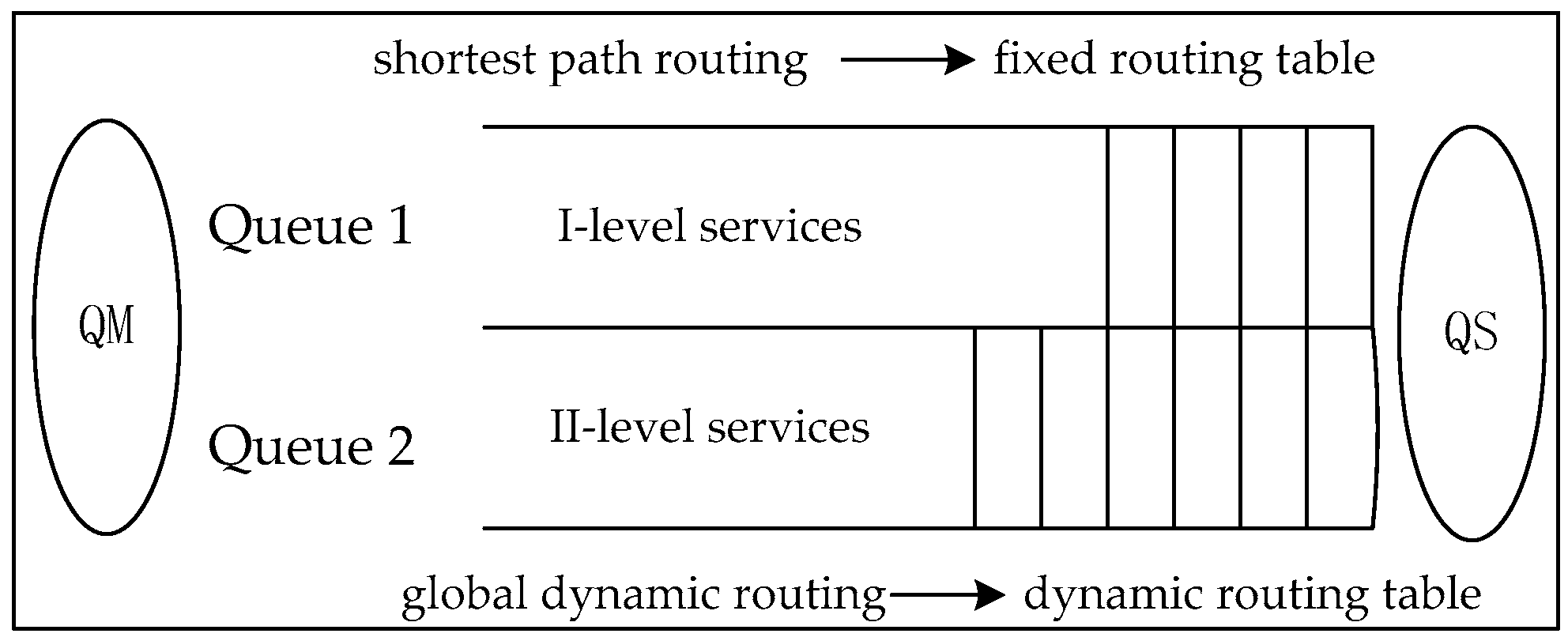

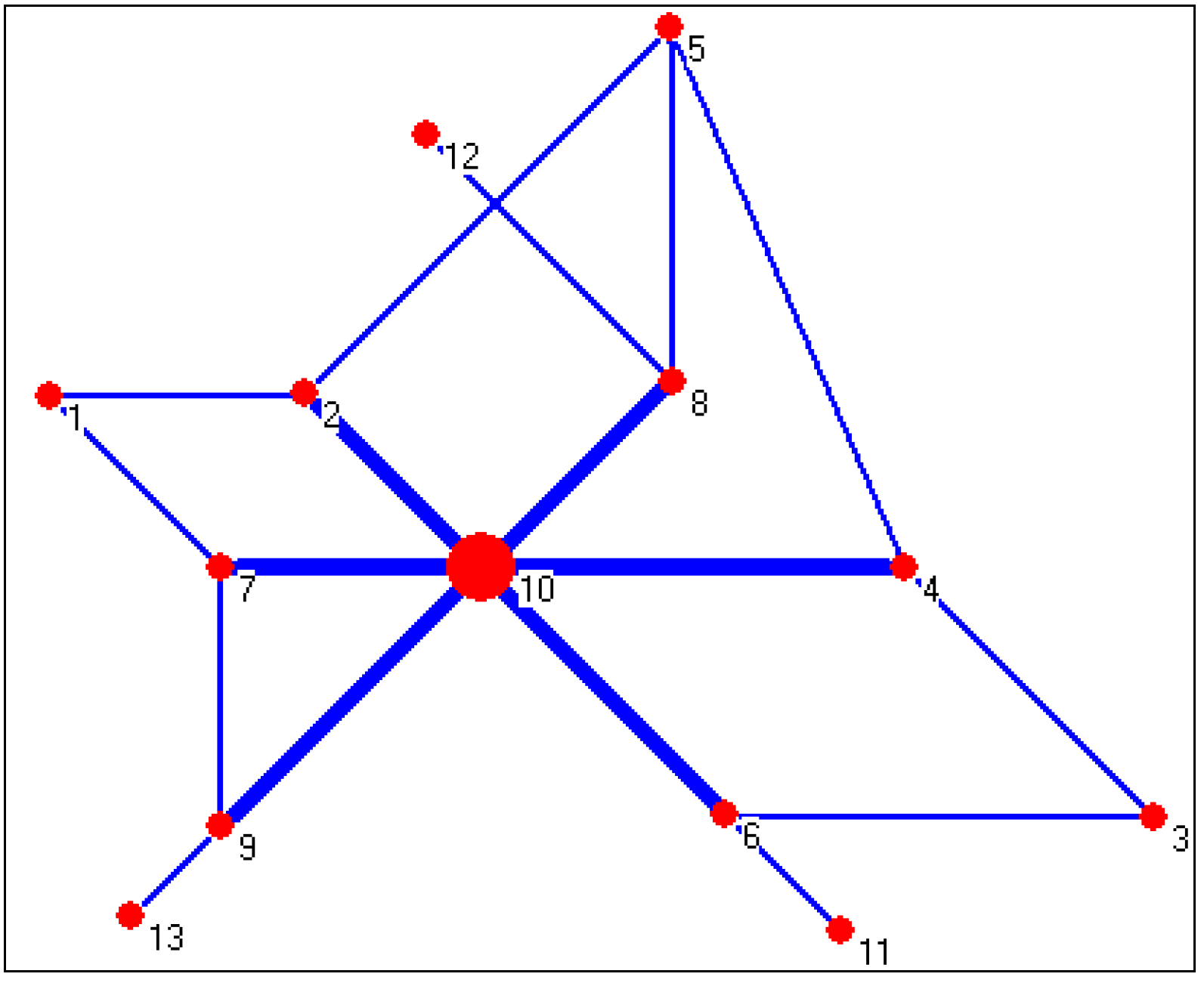
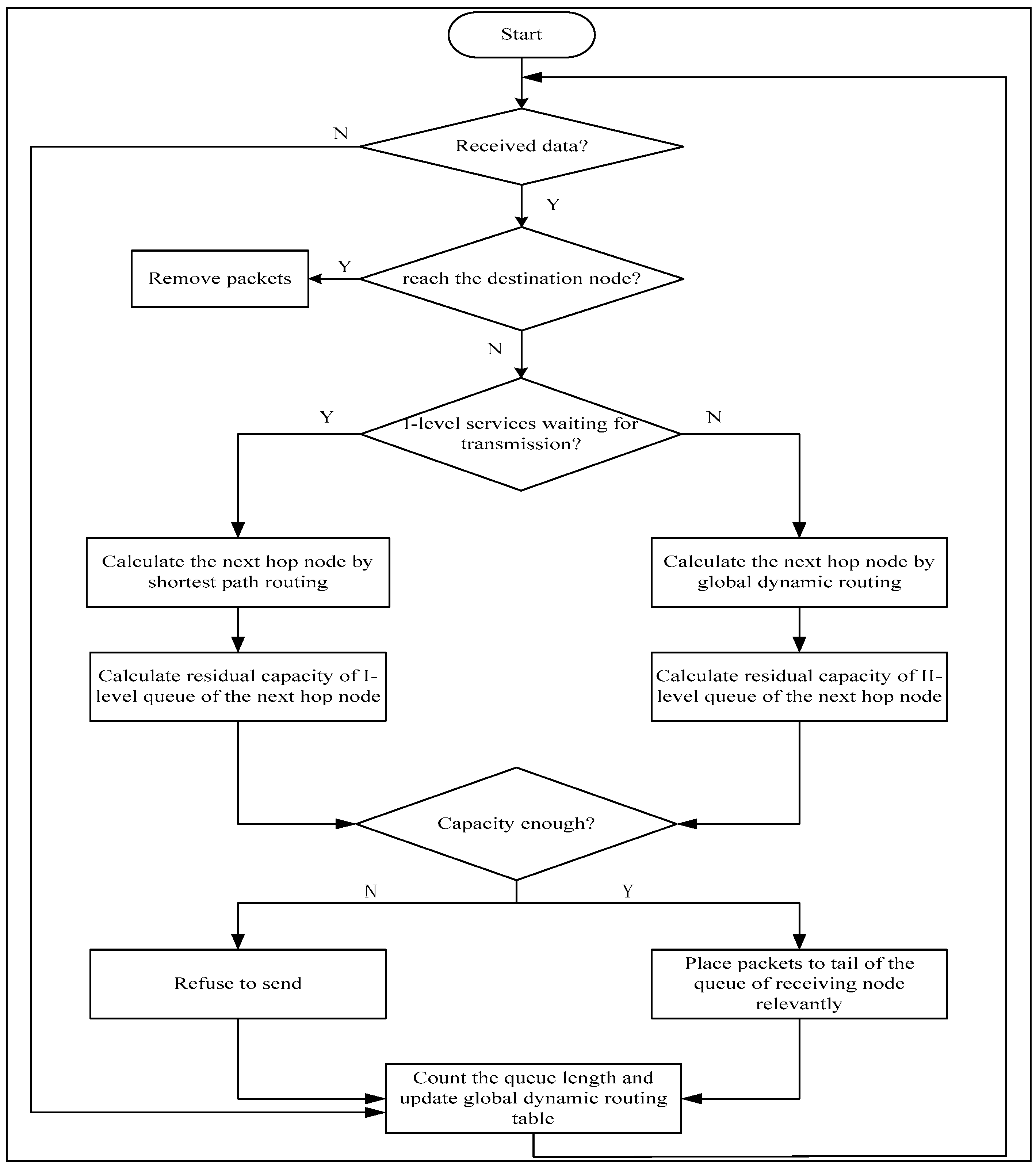

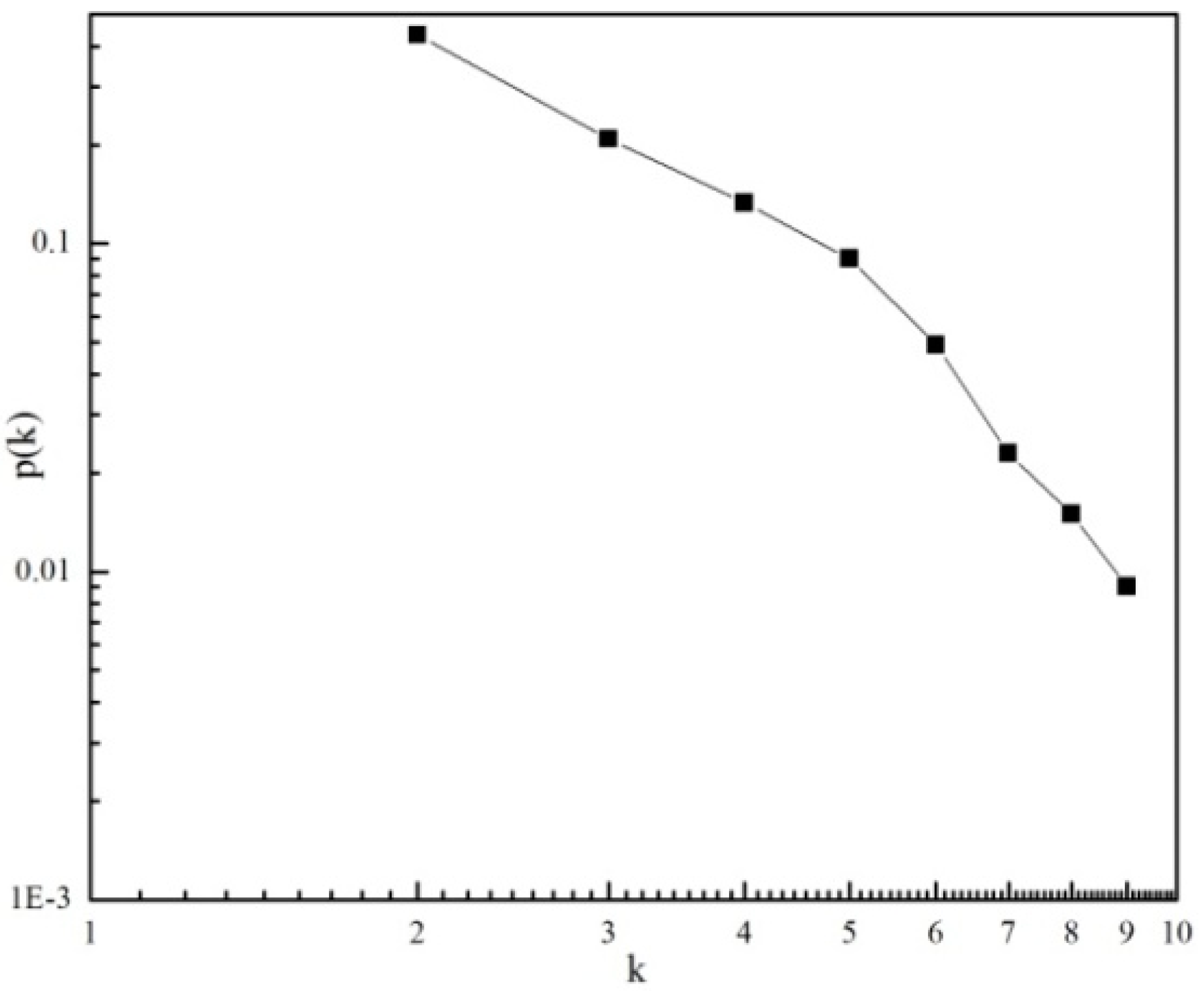
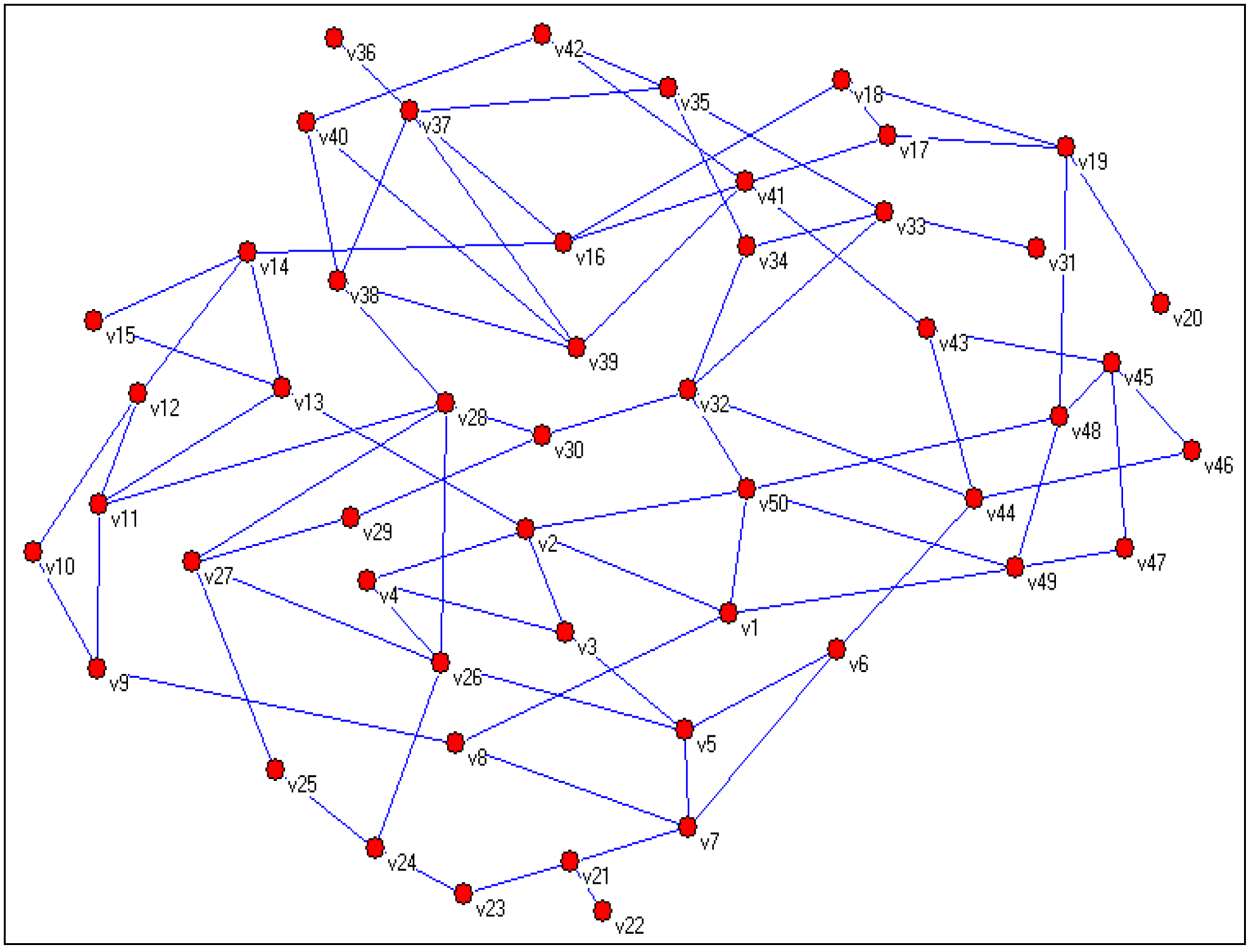

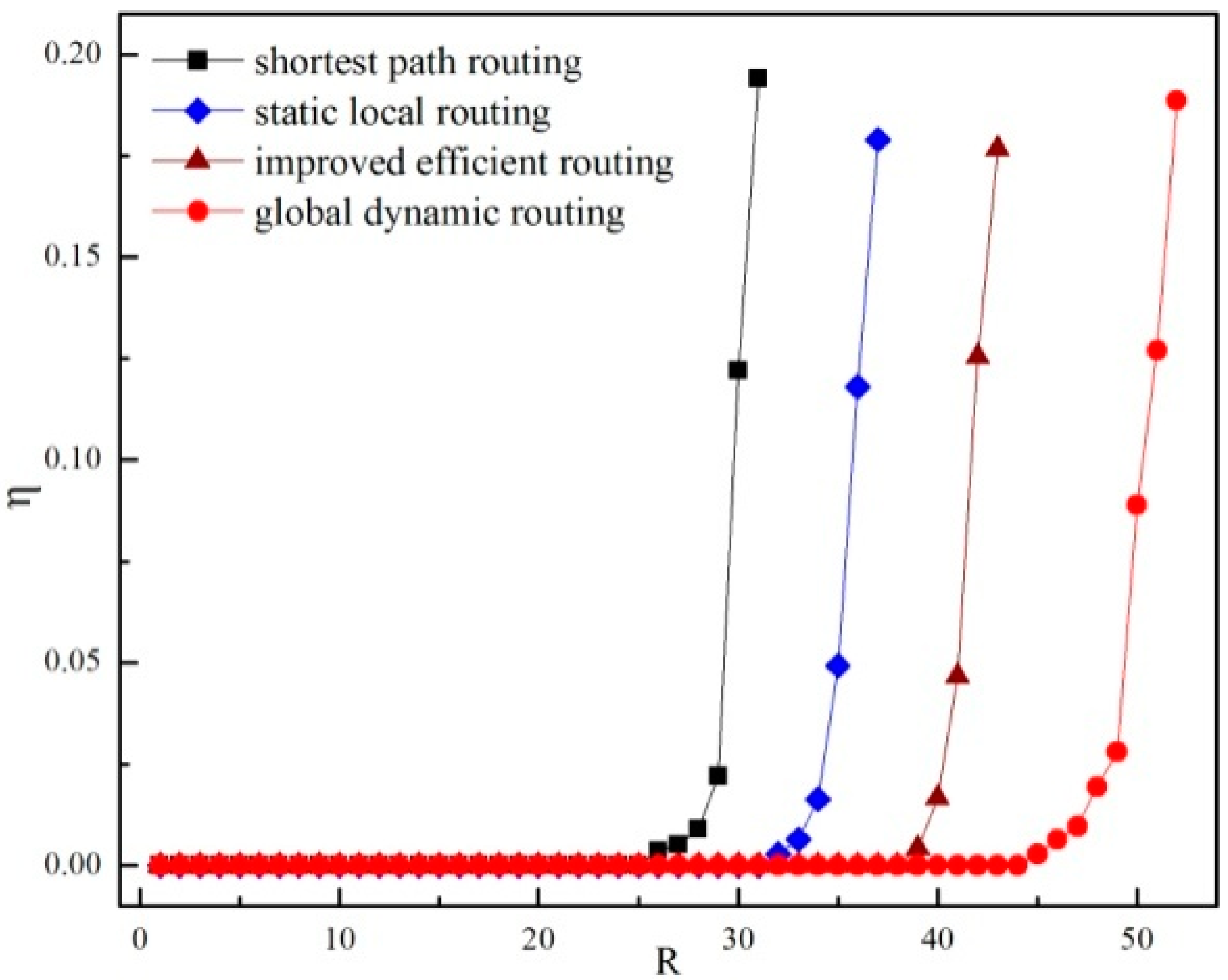

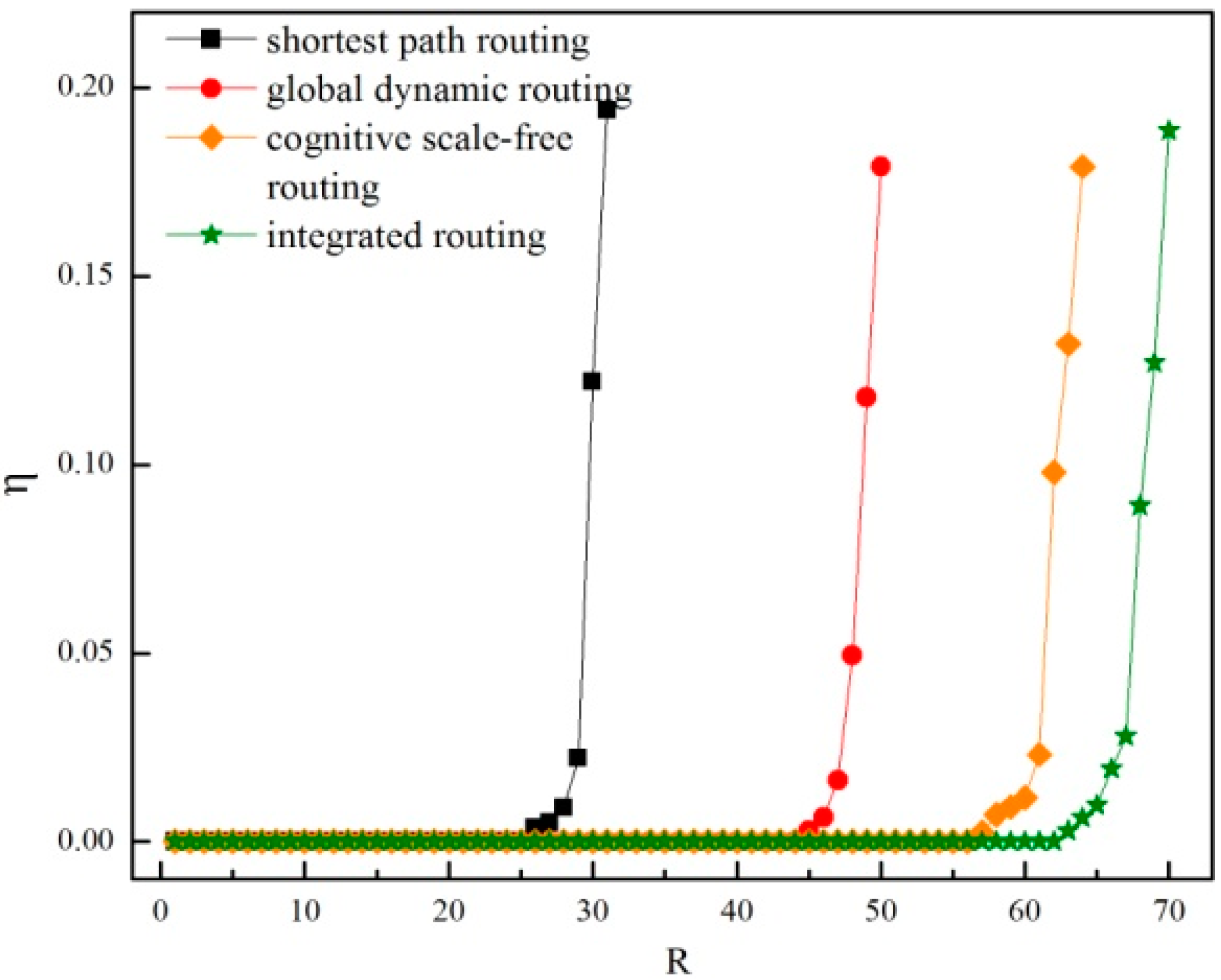
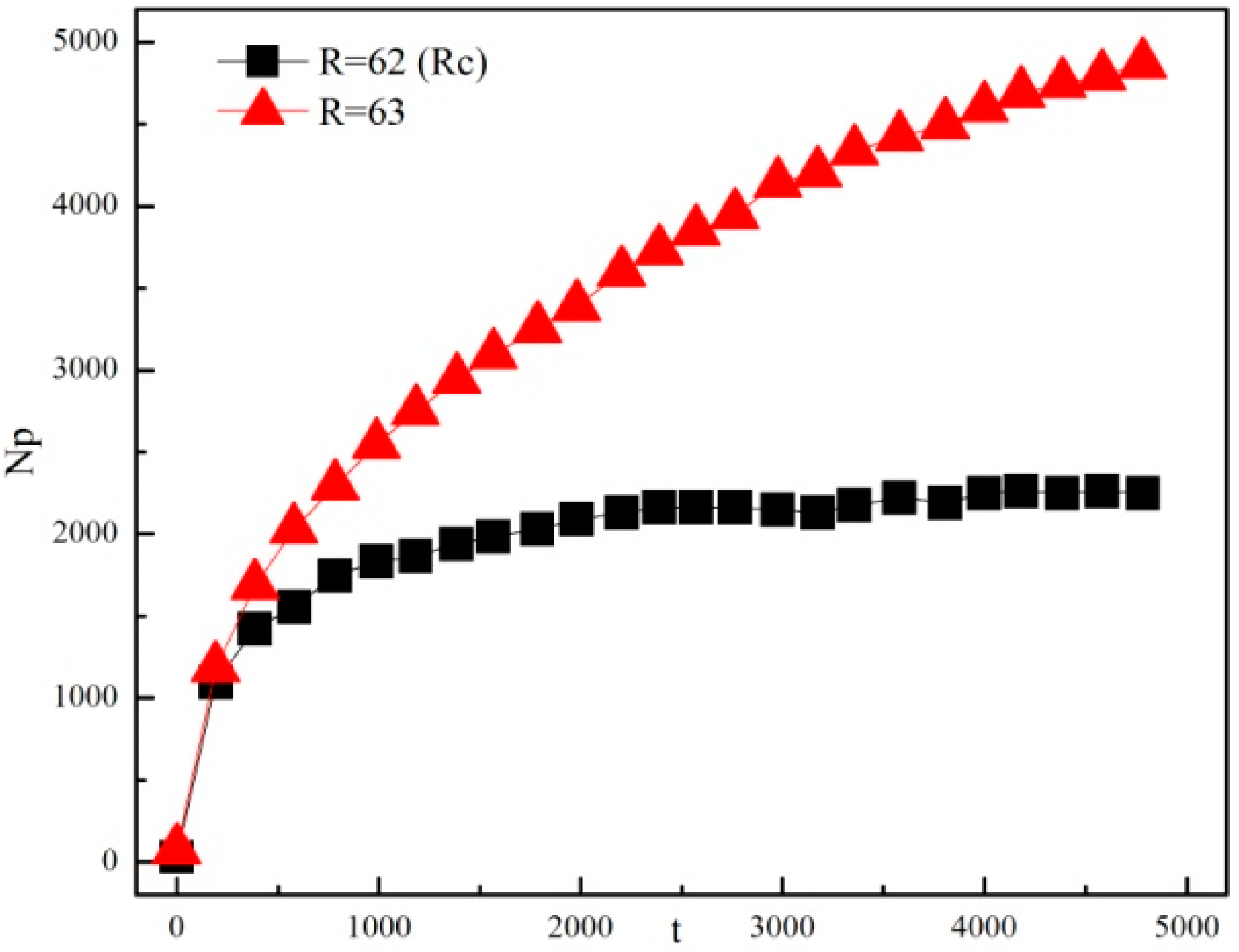

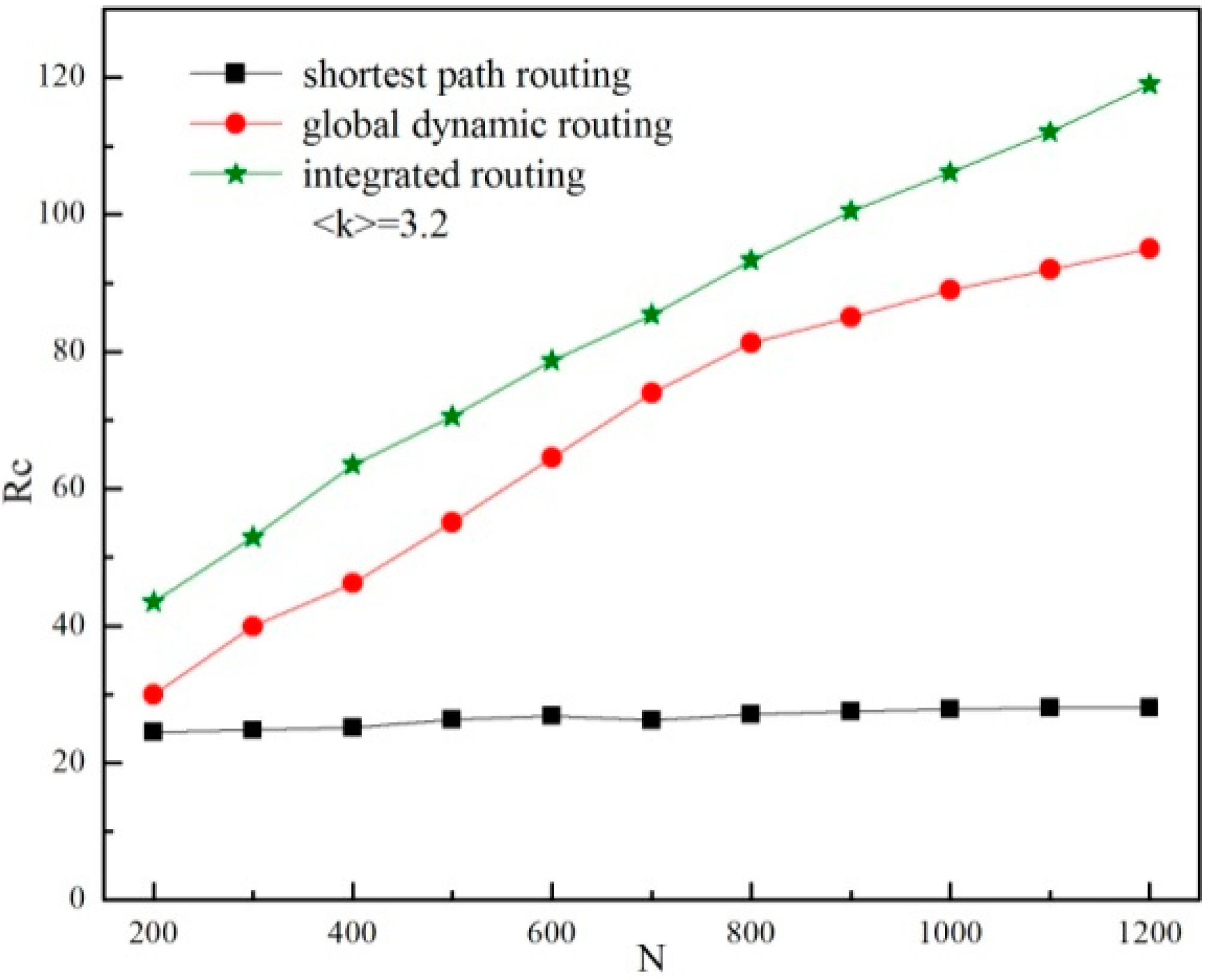

| Service Type | Examples |
|---|---|
| voice service | dispatching telephone, conference telephone, etc. |
| data service | line relay protection data, dispatching automation data, etc. |
| video service | remote video conference, surveillance video, etc. |
| I-Level | II-Level |
|---|---|
| relay protection data | video conference |
| safety and stability control data | lightning location monitoring |
| dispatching telephone | office automation |
| protection information management | electric metering telemetry |
| dispatching automation | video monitoring of substations |
| wide area measurement | administrative telephone |
| k | 1 | 2 | 3 | 4 | 5 |
| Nk | 0 | 252 | 111 | 71 | 48 |
| p(k) | 0 | 0.432 | 0.208 | 0.133 | 0.090 |
| k | 6 | 7 | 8 | 9 | ∑ |
| Nk | 26 | 12 | 8 | 5 | 533 |
| p(k) | 0.049 | 0.023 | 0.015 | 0.009 | 1 |
© 2017 by the authors. Licensee MDPI, Basel, Switzerland. This article is an open access article distributed under the terms and conditions of the Creative Commons Attribution (CC BY) license (http://creativecommons.org/licenses/by/4.0/).
Share and Cite
Xiang, M.; Qu, Q. A Congestion Control Strategy for Power Scale-Free Communication Network. Appl. Sci. 2017, 7, 1054. https://doi.org/10.3390/app7101054
Xiang M, Qu Q. A Congestion Control Strategy for Power Scale-Free Communication Network. Applied Sciences. 2017; 7(10):1054. https://doi.org/10.3390/app7101054
Chicago/Turabian StyleXiang, Min, and Qinqin Qu. 2017. "A Congestion Control Strategy for Power Scale-Free Communication Network" Applied Sciences 7, no. 10: 1054. https://doi.org/10.3390/app7101054




